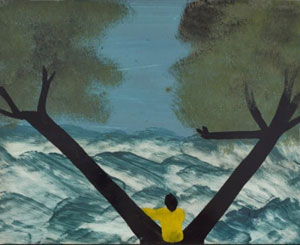9.11.24 — No Second Thoughts
Everything for Frank Walter was a throwaway—and everything a discovery of who and where he was. At his death in 2009, the black artist left thousands of paintings and drawings on top of hundreds of hours of tapes.
That is just for starters. His two thousand photographs run mostly to Polaroids, because what could come more quickly, with no chance for second thoughts? A stack of paper, a single manuscript, reaches easily to one’s waist. Who would dare to turn its pages even if one could touch? Who would dare, too, to call it a memoir, a fiction, or a lecture on art? And still he sought, as the show’s title puts it, “To Capture a Soul.” 
To be sure, there is hardly a soul in sight at the Drawing Center, through September 15. An African woman in pencil may not count as a portrait, no more than a young Fidel Castro nearby on the wall. They are emblems of something more lasting than a lifetime, much like his carved wood after African sculpture. If they are also suspiciously generic, he could live with that. Like all of nature, they respond to him—and, together with a recent report on another freewheeling black artist, Della Wells, it is the subject of a longer review in my latest upload. Does that make him an outsider artist, and what about Wells?
For so undisciplined an artist, Walter stuck to a task long after another would have moved on. He could well have been high-functioning autistic in his embrace of ritual, his refusal to hide anything, and his absence of confession. If there is a self-portrait anywhere in his work, apart from the body of work itself, it lies in an otherwise anonymous man up a tree. Yet he left his native Antigua in 1953, still in his twenties, to find the other half of his heritage, and he remained in Europe until 1961. Another artist might have spent those years in museums, to claim their tradition as his own, or immersed himself in white, African, and Caribbean communities for their humanity and culture. Walter headed for the library.
Or rather he headed for libraries, that marvel of English cities, because he could do nothing singly. And there he turned out one family tree after another. Naturally they are dense to the point of illegible, their words covering entire sheets. Who can say what sprang from library research, what from a remembered oral history, and what from an active imagination? They have a curious echo in drawings of actual trees, their leaves a splatter of red and black akin to an explosion. This artist’s god does and does not lie in the details.
Back home, he pursued the same uncanny mix of the obvious and unexpected. Maybe you know Antigua for sunlight and white sand. Walter sees rippling water in a dark wood, even as it emerges into the light. The sun rests on a mountain peak, like the product of a volcano. Animals are sketchier (and awfully cute), but they tend to one another when they are not looking at him. A cow jumps over a fence, if not the moon.
If they border on nursery rhymes, Walter wrote music, too, in typically sloppy but mostly accurate notation. Anything can go into the mix, and anything can as a ground for oil—including photocopies, disks of auto insulation, backs of unsold Polaroids, and boxes of film. The curator, Claire Gilman, arranges things roughly by subject, because she has no choice. Work from nearly sixty years is almost entirely undated. It may not be consistently great either, but he never have cared for greatness. He wanted only to see himself as part of a larger world.
If Walter leaves things a bit sketchy, Josh Smith embraces the charge. “This is how it is,” he writes—and it has to be, because it finds completion in what is yet to come. “It refers forward,” he claims of his work, but for once it also looks back, and he conceives his show in the Center’s back room as an homage to Walter, as “Life Drawing.” Is this real life? Since his debut in the 2009 New Museum “Generational,” Smith has become an art-world favorite for what another group show called “everyday abstraction.” Here, though, he tends to leaves, fish, birds, and palms as well.
If Walter makes art his fever dream and culture his library, Smith has appeared in a show of “The Feverish Library” as well, and he still piles it on. I have dismissed him more than once as slapdash, glib, and cheesy. There is no doubting, though, his facility and charm. Even the Grim Reaper looks anything but grim. Can he make Walters self-conscious childishness look downright grown-up? Maybe, he seems to say, there are limits to adulthood.
Read more, now in a feature-length article on this site.